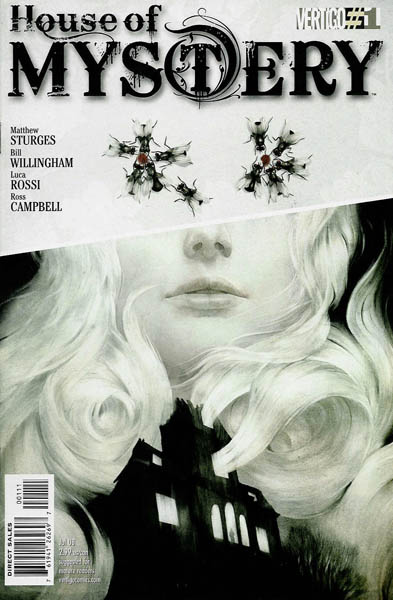Or – “The Vertigo Problem.”

Recently, Gatekeeper Manager Deon (who doesn’t get Howard The Duck, but somehow loves XO: Manowar) explained to me his problem with Vertigo comics: They’re just weird for weirdness’ sake. I don’t know how true that assessment is, but I can clearly see the kernel of truth at the bottom of that statement. I love classic Swamp Thing, I have read Hellblazer religiously since day one, I have all the Sandman trade paperbacks, I even loved Shade: The Changing Man. But there came a point where Vertigo seemed to have found a niche, a hook, and that hook was “Get the weird Gothy types.” House of Mystery is a very old-school Vertigo comic book, but is that necessarily a bad thing?
 Previously, on House Of Mystery: I think that the turning point was probably Neil Gaiman. More specifically Neil Gaiman’s Sandman, issue #8, “24 Hours.” The issue took an existing super-villain character (Doctor Destiny) and put that supernatural element in the midst of a group of normal people. Sexual themes, emotional diatribes, murder, and more were shoved into that issue, and it really set the tone for what a lot of Vertigo titles became. I also have a soft spot for the “Schrodinger’s Pizza” issue of Animal Man, where Buddy Baker is trapped in an alternate reality, surrounded by strange heroes, and explains the quantum theory of light based on whether or not a pizza has hot pepper. Hell, I’m even a fan of the moment where Herr Starr nukes The Saint of Killers, and the Saint steps out of the inferno, spits and snorts “Not enough gun.” But there came a point where the general public (as embodied by Deon) started to think of Vertigo as bisexual doing magic and talking in Tori Amos lyrics…Â
Previously, on House Of Mystery: I think that the turning point was probably Neil Gaiman. More specifically Neil Gaiman’s Sandman, issue #8, “24 Hours.” The issue took an existing super-villain character (Doctor Destiny) and put that supernatural element in the midst of a group of normal people. Sexual themes, emotional diatribes, murder, and more were shoved into that issue, and it really set the tone for what a lot of Vertigo titles became. I also have a soft spot for the “Schrodinger’s Pizza” issue of Animal Man, where Buddy Baker is trapped in an alternate reality, surrounded by strange heroes, and explains the quantum theory of light based on whether or not a pizza has hot pepper. Hell, I’m even a fan of the moment where Herr Starr nukes The Saint of Killers, and the Saint steps out of the inferno, spits and snorts “Not enough gun.” But there came a point where the general public (as embodied by Deon) started to think of Vertigo as bisexual doing magic and talking in Tori Amos lyrics…Â
This issue starts strong, with Cain and Abel (both supporting cast members of the much lamented Sandman series) having a conversation over tea. Well, actually, Cain is having a conversation… Abel is understandably distracted by being dead, with an axe in his chest. Cain lets himself out, and prepares to return to his home in the House of Mystery, comparing Abel’s House of Secrets poorly to his own more beautiful home. “Even though all mysteries contain secrets,” smugs Cain, “not all secrets contain mysteries.” Stepping out into the Dreaming, Cain is thunderstruck to find his home entirely GONE…
Some years later, we see a young woman running into the night, racing away from her own ruined home, carrying only a roll of papers with her, chased by mysterious figures who float in an eerie and evil fashion, their shoes dragging the street. She runs, and we suddenly switch to the long-missing House of Mystery, sitting on the edge of a cliff, as the inhabitants within sing one of their own off on her freedom. The various denizens of the House seem bitter, and it’s clear that the people here can’t leave. A cute redhead accosts a poet about why she can’t leave, and he points out the obvious… “How do you know this mysterious coachman doesn’t take our “Lucky Ones” to be tortured and killed?” “At least the torturing and killing would be a distraction,” she replies bitterly. As the girl leaves the House of Mystery, our running woman drops her papers, and we clearly see that she’s drawn the House of Mystery, in great detail. She runs and runs and runs like a constipated weiner dog, until she ducks through a mysterious door of great mystery.
Back at the house, the barman is serving a young girl name Hungry Sally and enormous repast, including an entire turkey, explaining that the only coin that pays in the House is a story. The story that Sally tells… is horrible. Horrible, compelling, and weird. She tells how she moves to a strange new town, and meets new people (who are giant houseflies.) She falls in love, gets married, and on her wedding night, she is taken by a giant fly (she herself is perfectly human) and they honeymoon. “I became with child right away, on our wedding night… which is a good omen.” The next sentence will disgust you, and I urge those of less sturdy constituations to move on down to the next paragraph. Sally gives birth, sort of, as dozens of giant maggots burst out of her back, and feed off her until they’re big enough to fly. She tells her story in perfectly normal terms, as we see the monstrous images that accompany them. “I was aloof from my maternal duties,” she says, as we see her, seemingly dead on the ground. “There’s a condition I’ve heard of, called post-partum depression, but I won’t try to use it as an excuse. Quite simply, idiscovered myself to be hollow and worthless as a wife and mother.”
We see everyone in the House staring at her, horrified as she talks and eats, and we see her from behind for the first time, her body hollowed out by the maggots, and everything she eats falls out into a waiting bucket. “It’s funny, though, how hungry I seem to be all the time now. No matter how much I eat, I never feel full anymore.” Gyaaah. The barman “rewards” her for her tale with a special seat all her own, which coincidentally puts her back to the wall. Back in the alleyway, the running woman ducks through a door, and finds herself in a strange hallway. She walks down the hall, opening a second door, and entering… the bar we’ve been seeing all issue. “Welcome to the House of Mystery,” says the sardonic redhead from before, “fabled in story and song. The first drink is on the house…”
I can’t decide what I think about this book. The script, by the Shadowpact team of Bill Willingham and Matt Sturges, is well done, and avoids many of the pitfalls of “Vertigo-itis,” but it does remind one of the Sandman quite strongly, especially the “World’s End” storyline, where various characters interact in an inn and swap stories. Willingham’s story of Sally’s marriage is very compelling, more so than the framing device that is probably meant the be the focus of the piece, and the art is quite strong throughout. Luca Rossi does a very good job keeping his characters distinct and giving them their own identity and personality. It’s a good issue, and there’s elements of what might be awesome here (see Fables #1 if you’re wondering what I mean) but right now, the jury is still out. It’s disturbing in parts, touching in others, and we’ll see exactly where it’s going. Right now, I’m happily confused, and willing to give the benefit of most of the doubt, awarding House of Mystery #1 a well-earned 3 out of 5 stars.




5 Comments
I’ve been catching “Dead of Night” off and on, which is Marvel’s relaunching of Man-Thing it seems. Apparently the big two are trying to jump back into the creepy horror genre.
I read this and am willing to continue checking it out.
I loved Sally’s story. Yes, it was disturbing, but when you want food, you tend to get very creative :)
I’m in for 12 issues to see where it goes.
However, you’re right, it is far too similar to Sandman: World’s End. Willingham tried to use the very same device previously for one of his obscure miniseries.
Another thing this feels too similar to in tone are the Thessaly Witch for Hire miniseries Bill Willingham wrote. I didn’t like those miniseries at all. The element of “Tongue in Cheek” was way too overpowering. He made the supernatural aspects of Thessaly’s world very quotidian, but too much soo.
Anyway, we’ll see where this goes.
1) I have seen at least three comic book stories more horrifyng than the Hungry Sally Story, all on the same website. No, I’m not telling you which.
2) The one flaw in this is…Cain got abel back in “The Wake” by complaining to Daniel, the King of Dreams. Why doesn’t he just do the same about his House, or even ask for a new one?
I think its unfair to compare the storytelling device to Sandman. I mean, the book is technically a spinoff of that series anyway, so there’s very likely a lot of homage at work. Not to mention that the Sandman wasn’t the first to use that device by far. You may as well compare both works to Chaucer’s Canterbury Tales and be done with it.